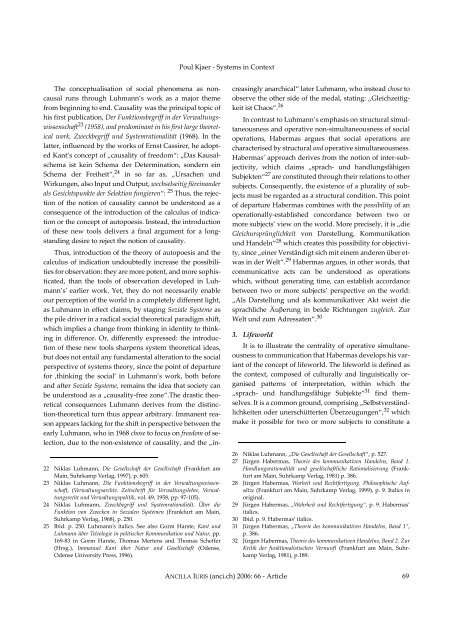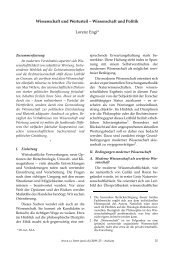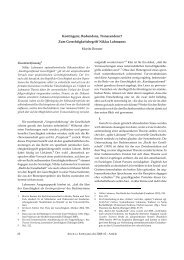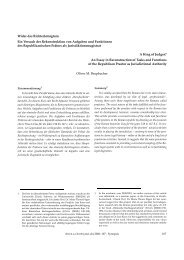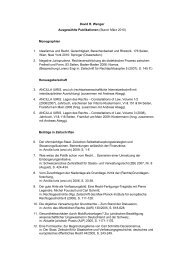On the outcome of the Habermas/Luhmann-debate
On the outcome of the Habermas/Luhmann-debate
On the outcome of the Habermas/Luhmann-debate
Create successful ePaper yourself
Turn your PDF publications into a flip-book with our unique Google optimized e-Paper software.
The conceptualisation <strong>of</strong> social phenomena as non‐<br />
causal runs through <strong>Luhmann</strong>’s work as a major <strong>the</strong>me<br />
from beginning to end. Causality was <strong>the</strong> principal topic <strong>of</strong><br />
his first publication, Der Funktionsbegriff in der Verwaltungs‐<br />
wissenschaft 23 (1958), and predominant in his first large <strong>the</strong>oret‐<br />
ical work, Zweckbegriff und Systemrationalität (1968). In <strong>the</strong><br />
latter, influenced by <strong>the</strong> works <strong>of</strong> Ernst Cassirer, he adopt‐<br />
ed Kant’s concept <strong>of</strong> „causality <strong>of</strong> freedom“: „Das Kausal‐<br />
schema ist kein Schema der Determination, sondern ein<br />
Schema der Freiheit“, 24 in so far as, „Ursachen und<br />
Wirkungen, also Input und Output, wechselseitig füreinander<br />
als Gesichtspunkte der Selektion fungieren“: 25 Thus, <strong>the</strong> rejec‐<br />
tion <strong>of</strong> <strong>the</strong> notion <strong>of</strong> causality cannot be understood as a<br />
consequence <strong>of</strong> <strong>the</strong> introduction <strong>of</strong> <strong>the</strong> calculus <strong>of</strong> indica‐<br />
tion or <strong>the</strong> concept <strong>of</strong> autopoesis. Instead, <strong>the</strong> introduction<br />
<strong>of</strong> <strong>the</strong>se new tools delivers a final argument for a long‐<br />
standing desire to reject <strong>the</strong> notion <strong>of</strong> causality.<br />
Thus, introduction <strong>of</strong> <strong>the</strong> <strong>the</strong>ory <strong>of</strong> autopoesis and <strong>the</strong><br />
calculus <strong>of</strong> indication undoubtedly increase <strong>the</strong> possibili‐<br />
ties for observation: <strong>the</strong>y are more potent, and more sophis‐<br />
ticated, than <strong>the</strong> tools <strong>of</strong> observation developed in Luh‐<br />
mann’sʹ earlier work. Yet, <strong>the</strong>y do not necessarily enable<br />
our perception <strong>of</strong> <strong>the</strong> world in a completely different light,<br />
as <strong>Luhmann</strong> in effect claims, by staging Soziale Systeme as<br />
<strong>the</strong> pile driver in a radical social <strong>the</strong>oretical paradigm shift,<br />
which implies a change from thinking in identity to think‐<br />
ing in difference. Or, differently expressed: <strong>the</strong> introduc‐<br />
tion <strong>of</strong> <strong>the</strong>se new tools sharpens system <strong>the</strong>oretical ideas,<br />
but does not entail any fundamental alteration to <strong>the</strong> social<br />
perspective <strong>of</strong> systems <strong>the</strong>ory, since <strong>the</strong> point <strong>of</strong> departure<br />
for ‚thinking <strong>the</strong> social’ in <strong>Luhmann</strong>’s work, both before<br />
and after Soziale Systeme, remains <strong>the</strong> idea that society can<br />
be understood as a „causality‐free zone“.The drastic <strong>the</strong>o‐<br />
retical consequences <strong>Luhmann</strong> derives from <strong>the</strong> distinc‐<br />
tion‐<strong>the</strong>oretical turn thus appear arbitrary. Immanent rea‐<br />
son appears lacking for <strong>the</strong> shift in perspective between <strong>the</strong><br />
early <strong>Luhmann</strong>, who in 1968 chose to focus on freedom <strong>of</strong> se‐<br />
lection, due to <strong>the</strong> non‐existence <strong>of</strong> causality, and <strong>the</strong> „in‐<br />
22 Niklas <strong>Luhmann</strong>, Die Gesellschaft der Gesellschaft (Frankfurt am<br />
Main, Suhrkamp Verlag, 1997), p. 605.<br />
23 Niklas <strong>Luhmann</strong>, Die Funktionsbegriff in der Verwaltungswissen‐<br />
schaft, (Verwaltungsarchiv. Zeitschrift für Verwaltungslehre, Verwal‐<br />
tungsrecht und Verwaltungspolitik, vol. 49, 1958, pp. 97‐105).<br />
24 Niklas <strong>Luhmann</strong>, Zweckbegriff und Systemrationalität. Über die<br />
Funktion von Zwecken in Sozialen Systemen (Frankfurt am Main,<br />
Suhrkamp Verlag, 1968), p. 250.<br />
25 Ibid. p. 250. <strong>Luhmann</strong>’s italics. See also Gorm Harste, Kant und<br />
<strong>Luhmann</strong> über Teleologie in politischer Kommunikation und Natur, pp.<br />
169‐83 in Gorm Harste, Thomas Mertens and Thomas Scheffer<br />
(Hrsg.), Immanuel Kant über Natur und Gesellschaft (Odense,<br />
Odense University Press, 1996).<br />
Poul Kjaer ‐ Systems in Context<br />
creasingly anarchical“ later <strong>Luhmann</strong>, who instead chose to<br />
observe <strong>the</strong> o<strong>the</strong>r side <strong>of</strong> <strong>the</strong> medal, stating: „Gleichzeitig‐<br />
keit ist Chaos“. 26<br />
In contrast to <strong>Luhmann</strong>’s emphasis on structural simul‐<br />
taneousness and operative non‐simultaneousness <strong>of</strong> social<br />
operations, <strong>Habermas</strong> argues that social operations are<br />
characterised by structural and operative simultaneousness.<br />
<strong>Habermas</strong>’ approach derives from <strong>the</strong> notion <strong>of</strong> inter‐sub‐<br />
jectivity, which claims „sprach‐ und handlungsfähigen<br />
Subjekten“ 27 are constituted through <strong>the</strong>ir relations to o<strong>the</strong>r<br />
subjects. Consequently, <strong>the</strong> existence <strong>of</strong> a plurality <strong>of</strong> sub‐<br />
jects must be regarded as a structural condition. This point<br />
<strong>of</strong> departure <strong>Habermas</strong> combines with <strong>the</strong> possibility <strong>of</strong> an<br />
operationally‐established concordance between two or<br />
more subjects’ view on <strong>the</strong> world. More precisely, it is „die<br />
Gleichursprünglichkeit von Darstellung, Kommunikation<br />
und Handeln“ 28 which creates this possibility for objectivi‐<br />
ty, since „einer Verständigt sich mit einem anderen über et‐<br />
was in der Welt“. 29 <strong>Habermas</strong> argues, in o<strong>the</strong>r words, that<br />
communicative acts can be understood as operations<br />
which, without generating time, can establish accordance<br />
between two or more subjects’ perspective on <strong>the</strong> world:<br />
„Als Darstellung und als kommunikativer Akt weist die<br />
sprachliche Äuβerung in beide Richtungen zugleich. Zur<br />
Welt und zum Adressaten“. 30<br />
3. Lifeworld<br />
It is to illustrate <strong>the</strong> centrality <strong>of</strong> operative simultane‐<br />
ousness to communication that <strong>Habermas</strong> develops his var‐<br />
iant <strong>of</strong> <strong>the</strong> concept <strong>of</strong> lifeworld. The lifeworld is defined as<br />
<strong>the</strong> context, composed <strong>of</strong> culturally and linguistically or‐<br />
ganised patterns <strong>of</strong> interpretation, within which <strong>the</strong><br />
„sprach‐ und handlungsfähige Subjekte“ 31 find <strong>the</strong>m‐<br />
selves. It is a common ground, comprising „Selbstverständ‐<br />
lichkeiten oder unerschütterten Überzeugungen“, 32 which<br />
make it possible for two or more subjects to constitute a<br />
26 Niklas <strong>Luhmann</strong>, „Die Gesellschaft der Gesellschaft“, p. 527.<br />
27 Jürgen <strong>Habermas</strong>, Theorie des kommunikativen Handelns, Band 1.<br />
Handlungsrationalität und gesellschaftliche Rationalisierung (Frank‐<br />
furt am Main, Suhrkamp Verlag, 1981) p. 386.<br />
28 Jürgen <strong>Habermas</strong>, Warheit und Rechtfertigung. Philosophische Auf‐<br />
sätze (Frankfurt am Main, Suhrkamp Verlag, 1999), p. 9. Italics in<br />
original.<br />
29 Jürgen <strong>Habermas</strong>, „Wahrheit und Rechtfertigung“, p. 9. <strong>Habermas</strong>’<br />
italics.<br />
30 Ibid. p. 9. <strong>Habermas</strong>’ italics.<br />
31 Jürgen <strong>Habermas</strong>, „Theorie des kommunikativen Handelns, Band 1“,<br />
p. 386.<br />
32 Jürgen <strong>Habermas</strong>, Theorie des kommunikativen Handelns, Band 2. Zur<br />
Kritik der funktionalistischen Vernunft (Frankfurt am Main, Suhr‐<br />
kamp Verlag, 1981), p.189.<br />
ANCILLA IURIS (anci.ch) 2006: 66 ‐ Article 69


